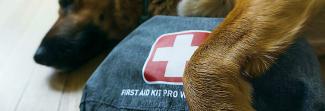One of my absolute favorite terms is “pet-friendly” — I love to take my dog with me on adventures as much as possible. So, I was thrilled to learn about a new program being introduced by the National Park Service: B.A.R.K. Rangers.
It’s a simple but brilliant way to promote responsible pet handling while also helping make national parks and monuments more welcoming to dogs. Handlers pledge to help their dogs follow the B.A.R.K. Ranger rules:
B – Bag your poop
A – Always wear a leash (6 feet max., and “don’t let your human leave you unattended”)
R – Respect wildlife (Don’t harass or harm wildlife by making noise or chasing them)
K – Know where you can go (parking lots, campgrounds, picnic areas, roads and designated trails)
The B.A.R.K. Ranger program isn’t widespread yet, but I’m hoping it will gain traction soon. Two of the flagship sites are Olympic National Park in Washington State and Montezuma Castle National Monument near Camp Verde, Arizona (about 50 miles south of Flagstaff).
Since Camp Verde is just a 6-hour drive from my home in Durango, Colorado, I was itching to head there and have Rio become an official B.A.R.K. Ranger. A call to Demii Grant, visitors use assistant, convinced me. She helped introduce the program to Montezuma Castle in 2016; her dogs Caesar and Coca were the monument’s first B.A.R.K. Rangers.
“The reason we introduced the program is because we want to continue to be a pet-friendly park, and we want to educate and promote responsible pet owners,” she said. “I love having my dogs with me, and I think it’s beneficial for people. As long as you’re responsible with your pet and know your pet, we’d love to have them come to our site.”
A few days later, I was on a road trip there with my husband Bryan and our Lab mix, Rio. Inside the bustling visitor center, we paid the admission fee and met with Ranger Debbie to go over the B.A.R.K. Ranger rules. Rio was an instant hit — kids wanted to pet him, adults asked his name (and wanted to pet him, too). As I tried to snap a photo of Rio with a cutout of Teddy Roosevelt, a British tourist offered to take one of us together while his son made silly faces and noises to get Rio’s attention.
Poop bags in hand, we headed past the flute player toward the main attraction: Montezuma Castle. Southern Sinagua farmers built the five-story, 20-room cliff dwelling between 1100 and 1300. On the trail, people looking up exclaimed things like, “Those must have been long ladders!” People looking down said things like, “That’s a big boy!” and “What kind of dog is that?” Like a good B.A.R.K. Ranger, Rio stayed on the trail (it was lined with foxtails, another incentive to follow the rules) and soaked up all the sights, smells and attention.
Back at the visitor center, we paid $5 for a B.A.R.K. Ranger dog tag. Rio showed it off while we cooled down in the shade, and we told a man with a dog named Azul about the program. After Rio and Azul sniffed and wagged, the newcomers headed inside to sign up.
My family spent the rest of the afternoon visiting two other sister sites. Montezuma Well is a stunning lake in the middle of the desert. Though I’d heard that local shelter dogs become B.A.R.K. Rangers and hike there for socialization before they’re adopted, part of me suspected the volunteer ranger who greeted us in the parking lot would say, “Sorry — no dogs allowed.”
Instead, she asked if she could give Rio a dog biscuit. The two rangers were instant BFFs!
We stuck to the trail and made sure to keep Rio out of the limestone sink, which is filled with endemic leeches. It’s not a swimming spot, but it gave us some great photo ops. We loved meeting another B.A.R.K. Ranger named Lola — and she loved the Zuke’s treats I offered.
Our last stop was Tuzigoot National Monument, which is an Apache word for “crooked water.” It’s at the summit of a long ridge with views of the Verde Valley. It was fun to watch Rio climb the steps to the top — and try to kiss the ears of the woman who started cooing, “What a beautiful dog” on her way up. Bryan and I soaked in the views and wondered about the lives of the people who lived there centuries before. Rio wagged hopefully at new friends, hoping — as always — for more treats.
The B.A.R.K. Ranger program led us to a fun day we wouldn’t have had otherwise. I hope the program expands throughout the park service so that responsible dog owners and our pups can prove that every national park and monument should be pet friendly!
Dog-Friendly National Parks
Here’s a partial list of national parks that welcome dogs courtesy of GoPetFriendly.com. Dogs may be restricted to certain areas, so check the rules first before heading out with your pup.
- Acadia National Park
- Cuyahoga Valley National Park
- Grand Canyon National Park
- Great Sand Dunes National Park
- Mammoth Cave National Park
- Shenandoah National Park
- Yosemite National Park
- Rocky Mountain National Park
- Badlands National Park
- Montezuma Castle National Monument
- Olympic National Park
